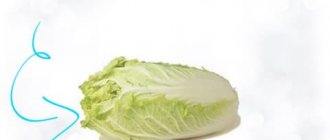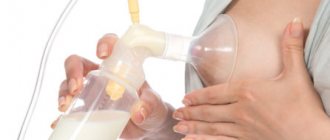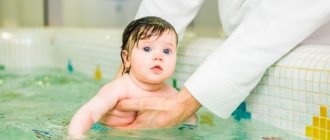Repair and decoration
04/02/2018 Anastasia Prozheva
The mother performs the first hygiene procedures for her newborn baby after returning from the maternity hospital. In the evening, shortly before going to bed, the baby is bathed with soap. It should be taken into account that if the baby was vaccinated in the maternity hospital before discharge, then bathing should be postponed for a day. Upon returning home, for the first time, protecting the umbilical wound and allowing it to heal, the baby is bathed with boiled water. Boiling softens the water and destroys any viruses that may be in it. If it is not possible to boil it in advance, then you can add a solution of potassium permanganate until it turns pale pink.
Bathing a newborn
All the time until the wound on the navel heals, and this usually happens in 12-16 days, the water for bathing must be boiled. When the navel is dry and clean, the baby can be washed with plain water without any additives. For young, inexperienced parents of a newborn baby, the first baths are usually associated with certain fears. They can be recommended to watch how to organize the first bath of a newborn in the bathtub - a video lesson presented on our website. Over time, having learned the secrets of mastery in parenting, they will carry them out with ease.
Newborn's first bath
Since bathing the baby will be regular, you will need a special container, it will make this hygienic procedure as comfortable as possible. Although some parents prefer to bathe their newborn in a large bathtub, the video below tells you what you need to know to do this. After all, in essence, doing this is not prohibited; of course, the container must be thoroughly washed and disinfected. But it is quite difficult to constantly maintain perfect cleanliness of a tank intended for general use. That is why a bathtub for bathing newborns is much more convenient in this regard. Its small size makes it much easier to keep clean.
Another plus in favor of such a container is that you can fill it faster and maintain the desired water temperature.
If you are for "big water"
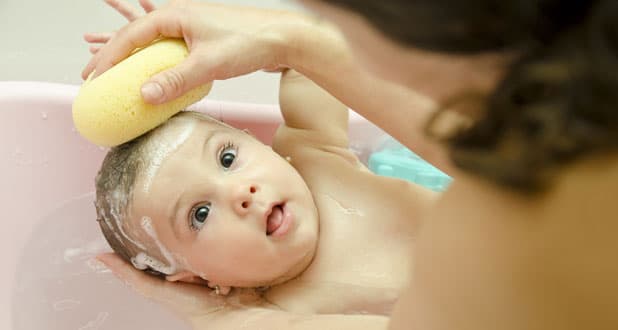
Be sure to measure the water in the bath before bathing - and in different places, as it may warm up unevenly. Stir the water thoroughly and measure its temperature again. Comfortable values for a baby are 36 −36.5 degrees.
Remember - the water in a large bathtub cools quickly. So give your baby a bath right away. For the first time, lower your baby into the bath very carefully, saying gentle, soothing words. The duration of the first long swim should not exceed 10 minutes if the baby is comfortable in the water. If you notice that he is starting to get nervous, immediately take him out of the water.
It is better to spend the first bathing sessions without a circle-collar, so as not to frighten the child. If you see that your baby feels absolutely comfortable in a large bathtub and is happily floundering in the water, you can carefully, without scaring him, put the circle on him before the next dive.
If you are afraid in advance that your baby will have a negative reaction to a large bath, scatter a couple of colorful floating toys over the water. A 2-3 month old baby will certainly be interested in bright objects and will not react so strongly to the replacement of a small bath with a large “pool”.
What kind of bath should a child have?
Today, a variety of children's bathtubs are produced. For example, children's devices for water procedures that have an anatomical shape are often found on sale. Thanks to the headrest and corrugated bottom, the child cannot submerge much into the water. Its disadvantage is that because of the slide, the baby cannot be placed on his tummy, i.e. he will not be able to swim freely.
Related article: DIY window frame: designs
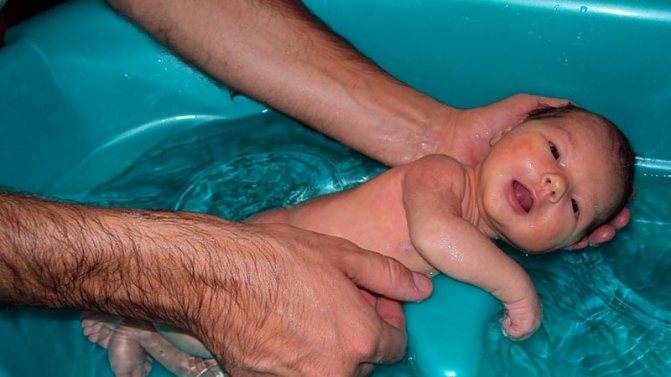
Bathing a newborn in a baby bath
In some models, the embossed bottom is created by a special silicone mat, held with suction cups, which is used in both children's and adult bathing containers. If such a bathtub for newborns is sold with a bathtub stand, then another advantage is its reliable fastening. But there is also a drawback to such an addition - you will have to select a model so that the bathtub stand matches the size of the large container.
The most popular and therefore the most sought after is the classic model. Everyone knows this familiar cup-shaped container; in any hardware store it is presented in a large assortment. The products differ from each other only in size, design and cost. This capacity is undoubtedly larger than the anatomical model, but this is a disadvantage for it. Since the baby will have to be held in her hand, the mother cannot do without an assistant. The solution in this case may be to buy a slide.
But such a bathtub for bathing newborns, the photo of which is presented below, is also affectionately called “mom’s tummy”; it can rarely be found on sale. Since this cup-shaped round container has fairly high sides, the crumbs in it are in the same position as in mom’s tummy. It is believed that bathing in a round bowl helps reduce colic in a newborn's stomach. The downside is that you have to adapt to using the bowl, since you can only sit in it.
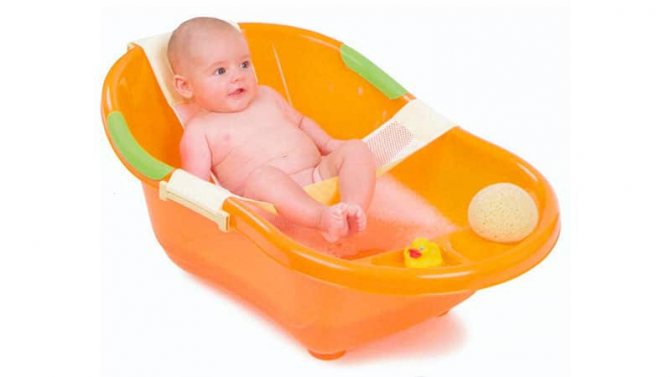
Newborn bathtub
A number of companies produce antibacterial baths for newborns made of antiseptic plastic with a microban, thanks to which its surface is protected from bacteria. This eliminates the need for disinfection every time.
This model is usually bought by parents who want to prevent their baby from becoming allergic to cleaning agents and disinfectants at the same time.
Many stores today sell a special bath stand for newborns. Such structures are quite stable. They are convenient because the mother does not have to bend low over the baby when bathing. Such a stand can be mobile on wheels or stand on legs. The bowl and stand can be easily moved around the room. The design is convenient to store, since it can be folded compactly and does not take up much space; this is especially true for cramped apartments.
Related article: Warm floor under carpet: how to do it yourself
Pros and cons of bathing with your baby
Bathing in the bath with mom brings a lot of useful emotions for the child. If there is a loved one next to the baby, he:
- less afraid of water (read also: What to do if a child is afraid to swim in the bathroom);
- feels safe;
- satisfied with water procedures;
- calm, because Mom is nearby.
Swimming with one of the parents will bring pleasure to the child and help him fall in love with water procedures.
There are practically no downsides to swimming together. The only thing is that parents need to thoroughly clean the bathtub every day before bathing the baby. But if everyone in the family is accustomed to maintaining hygiene, then such treatment will not lead to additional difficulties.
Bathing rules
There is nothing wrong with swimming together, but hygiene and special rules must be observed:
- Before taking a bath with the baby, the parent must wash himself.
- If mom or dad suffers from a fungal or skin disease, joint water procedures with a small child are prohibited.
- You cannot swim with your baby if the adult is not feeling well. He may lose consciousness and drop the baby.
- The optimal temperature for bathing a baby is 37 degrees (read also: Optimal water temperature for bathing a newborn baby).
- You need to dip your baby into the water slowly so as not to scare him.
- You should not leave the bath with your baby in your arms, as you risk dropping him. It is best to give the baby to another adult while in the water, and then go out yourself.
- Doctors do not recommend bathing a child with an unhealed umbilical wound.
The child is not inclined to swim in large amounts of water without support. This creates fear in him and leads to a breakdown in contact between mother and child:
- anxiety, restlessness;
- poor sleep;
- breast refusal;
- Frequent, causeless crying.
All these are the consequences of stress from bathing in a large bath, diving, or using early swimming techniques. Some parents let their child go into a large bath with a circle around his neck. But the circle will not relieve the baby from the fear of being alone in an unfamiliar, frightening space. In addition, such support leads to clamps in the cervical region, which causes pain in the baby.
Important! It should be remembered that you can only bathe an infant in a baby bath, or bathe with your mother in the same bath, when the baby feels supported and can attach itself to the mother’s breast at any time.
Preparation for water procedures
Preparing for bathing a baby should be approached with the utmost seriousness, so as not to harm the little person through inept actions. Before water procedures you should:
- wash the bath well;
- Place a special non-slip mat on the bottom;
- check the water - it should be about 37 degrees;
- so that the water temperature does not change, it can be left flowing from the tap;
- the bath should not be filled more than halfway;
- add herbal infusions if desired;
- prepare diapers, towels and clean clothes for the baby;
- Comfortable air temperature for the bathroom is 22-25 degrees.
Bathing process
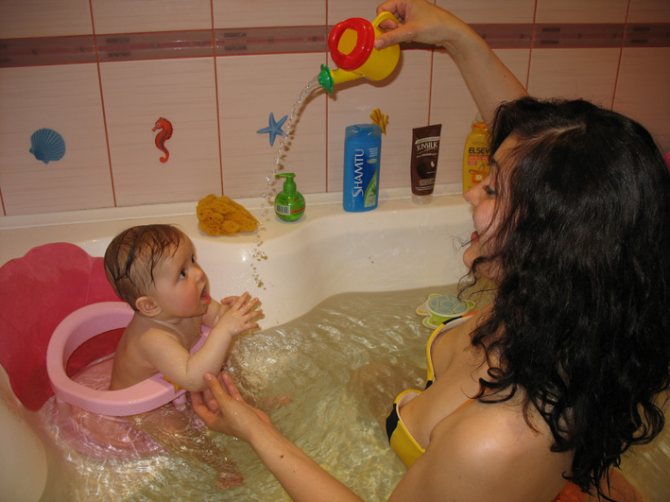
It is very important when bathing with your baby in a large bathtub to do everything correctly so that the child does not develop a fear of water. Children under three months of age are frightened by large volumes of water, so the baby should be immersed very carefully, holding it in an upright position.
- First, the baby’s legs are immersed in water, then the baby is placed on his back;
- the mother should remain calm during the bathing process, as her mood is largely transmitted to the baby. Sensing the anxiety of a loved one, the child will begin to get nervous and cry. At first, it is advisable to bathe the baby together;
- If the baby is fussy in the water, you can give him breastfeeding. Talk to him in a calm and gentle voice. He must feel his mother's presence all the time;
- you need to remove any negative factors that may upset or frighten the baby. Make sure that the water does not get into the baby’s nose and mouth and that it is at the recommended temperature, that is, 37 degrees;
- You should position yourself in the bath so that it is comfortable for both: mother and baby. It is best to place the baby in the corner between the mother’s stomach and legs. The baby's tummy and legs are covered with water;
- Bathing time should not exceed 15-20 minutes.
Important! You cannot leave the bath with your baby, there is a danger of falling, so first you give him to an assistant, or put him in a carrier, wrapped in a towel, and only then leave the bath.
When your baby learns to sit, he will happily splash around with you.
What to look for when making a choice
Of course, parents decide what to bathe their baby in. But in order for the bathing device to be convenient and functional, both for the baby and for his mother, you should pay attention to the following points:
- The product must be light. After all, mom will have to lift him, lower him and carry him. If it is heavy, it will make it difficult to perform all these operations.
- If a non-anatomical model is chosen, then it should contain removable devices that allow you to comfortably place the baby inside it.
- The bowl should not be slippery so that it is safe for the child to be in it.
- The material from which the product is made should not emit toxic substances during operation and should be easy to wash.
- The container must be stable. The presence of rubberized pads on its bottom will not allow it to slide. You cannot do without them even when the bath is placed in a large container.
What to do in case of secondary drowning
If a child was drowning and was “pumped out”, even if everything seems to be fine, you should seek medical help as quickly as possible - this is the only way to prevent dangerous consequences.
Be sure to show your baby to the pediatrician if you notice the signs listed above, or at least one of them, after he swallowed water.
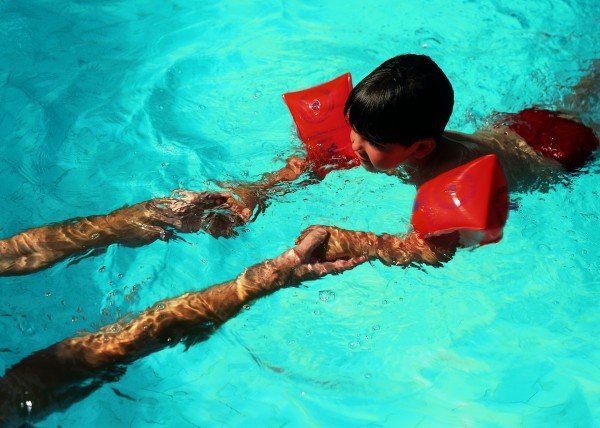
Stock Byte
Is it necessary to bathe your baby every day?
Water procedures are mandatory not only for hygienic reasons, it is a daily training of the body’s defenses, besides, the relaxing properties of water are good for the nervous system, and you should not be afraid of it, because it does not irritate the baby’s delicate skin. The frequency of bathing a newborn depends on his well-being and on the means that parents use. Of course, it is advisable to wash your baby daily until he is 6 months old. But if allergies or skin lesions occur, it is better to seek advice from a doctor. But carrying out water procedures when the temperature rises is strictly prohibited.
Rules for bathing babies from 6 months
Let's look at the rules regarding temperature, water quality, and safety precautions for bathing a 6-month-old newborn in a large bathtub.
Temperature
The temperature of the water depends on the goal pursued by the parents. If this is a hygienic cleansing procedure, then the temperature is maintained within 35-37⁰C. Warm water will wash away sweat and secretions from the skin. If the temperature is higher, there is a high risk of drying out thin skin. There is no need to steam the baby - there is no point or need for it.
If a family practices hardening evening bathing according to Komarovsky, then by six months the baby is already bathed in cool water at a temperature of 21-26⁰C .
The smaller the container and the room for maneuver, the warmer (but not hotter) the water should be. You should not practice hardening in a small bath - there is simply no room for the baby to move. A child will freeze if there is only room to lie down.
Water quality
If you adhere to the position that you can bathe the baby immediately after discharge from the hospital, use boiled water with potassium permanganate. Since the umbilical wound has not yet healed, you need to make the water as harmless as possible.
When bathing a baby with a healed umbilical wound, there is no need to boil water . Of course, the water must be clean, so it is advisable to use filtered water. Flowing water from the water supply is quite suitable. There is no need to further disinfect the water.
Safety precautions
- Under no circumstances should you leave your child unattended in the water.
- Prepare everything you need and place in advance in the bathtub and on the changing table any things that will be needed during bathing and after water procedures.
- Do not measure the water temperature by eye - a baby has thin and sensitive skin. Use a special thermometer.
- During the first month of life, the baby does not need active “washing”.
Hot water, soap and a washcloth will destroy lipid protection. If you bathe your baby frequently, dermatitis – inflammation of the skin – may occur. - Do not overheat the water to avoid drying out the skin.
- Do not pour water on the child's face - the baby will be scared. Carry out hygiene of the face, eyes and nose separately from bathing.
Other rules
Bathing rules:
- Give baths late in the evening to prepare your baby for bedtime.
- Bathe your baby in a warm, but not hot and stuffy room.
- For the first procedures, warm water without detergents is sufficient.
- Do not rub your baby's skin with a washcloth or sponge.
What you need to know about bathing your baby
Mothers often play it safe by disinfecting water with potassium permanganate, but do not forget that it makes the delicate baby skin dry, which is why it is not recommended to use it every day. Herbal infusions help soften hard water, but they also cannot be used often.
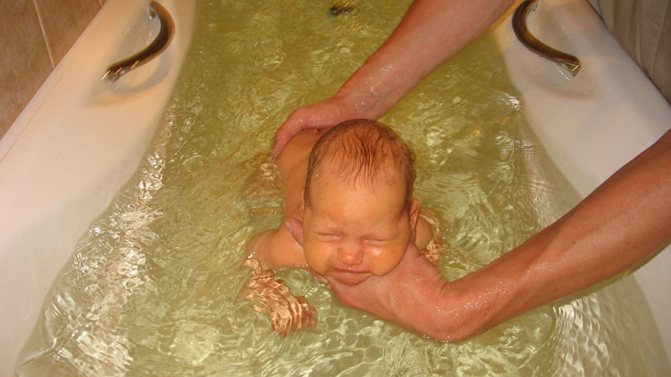
Bathing a newborn in a large bathtub
With daily bathing in any herbal mixture, the skin becomes dry, and the effect of herbs for a newborn is similar to a strong medicine. This is why pediatricians recommend using herbal teas only when necessary. For example, a bath with chamomile for a newborn will help cope with diaper rash and sweat rash. The effect of herbal treatment is noticeable after just a few treatments. A bath with a series for a newborn has an antiallergic effect on the skin, eliminating the manifestations of diathesis, but provided that the baby is not allergic to any component of the herb.
Related article: Manufacturers of bathroom furniture: should you choose a domestic or foreign brand?





